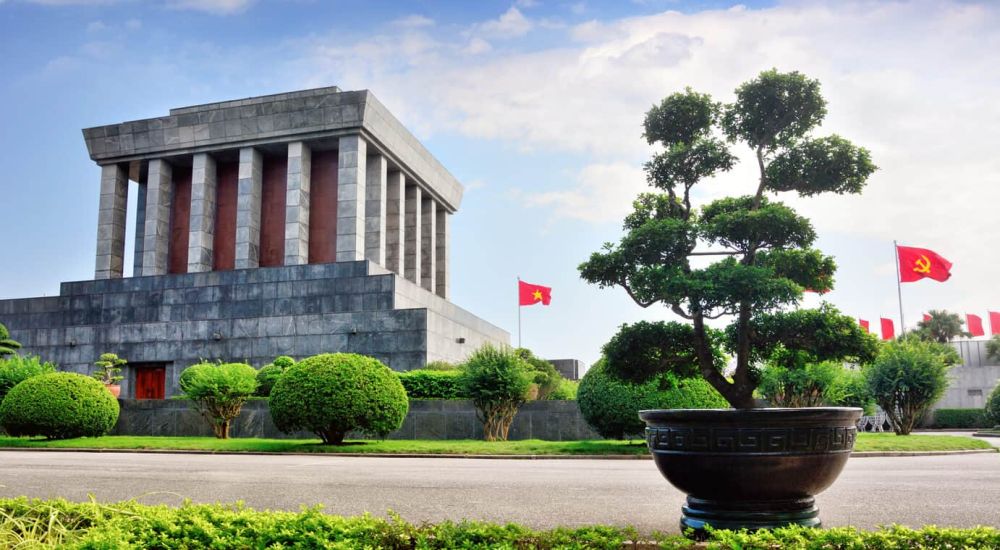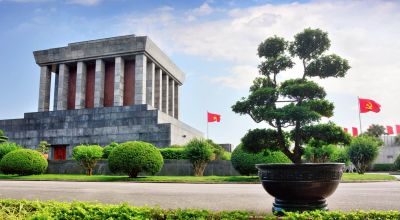

Explore the final resting place of Vietnam's most iconic leader, Ho Chi Minh, through a guided tour that offers a deep insight into his life and legacy. The Mausoleum is a monumental marble building located in Ba Dinh Square, where Ho Chi Minh read the Declaration of Independence in 1945. As you walk through the complex, you will learn about Uncle Ho's humble lifestyle by visiting the Presidential Palace, his Stilt House, and the One Pillar Pagoda, an emblematic Buddhist temple. Respectful attire and a solemn demeanor are required while visiting the Mausoleum itself, where you will see Ho Chi Minh's embalmed body on display. The tour provides a comprehensive understanding of Vietnamese historical culture and the significance of this sacred site to the nation.
Dedicated to the life and work of Ho Chi Minh, the museum offers an extensive collection of artifacts, photographs, and memorabilia related to the leader's life. Spanning several floors, the displays depict Ho Chi Minh’s contributions to the Vietnamese struggle for independence and provide context to the socio-political history of Vietnam. Visitors will get an opportunity to learn about Uncle Ho's childhood, his travels around the world seeking ways to liberate his country, and his leadership during the wars. The exhibition includes thought-provoking artworks and presentations, making it a valuable experience for history buffs and anyone interested in understanding Vietnam's past and national identity.
Witnessing the Changing of the Guard Ceremony at the Ho Chi Minh Mausoleum is a unique experience that reflects the precision and discipline of the Vietnamese military. The guards, dressed in crisp white uniforms, perform an elaborate drill routine when changing shifts, which happens every hour. The ceremony is a display of national pride and a tribute to Uncle Ho's legacy. Visitors are often deeply impressed by the silent, synchronized motions of the guards against the backdrop of the imposing mausoleum structure. The solemn nature of the ceremony and the picturesque surroundings make for an iconic Vietnamese cultural experience, leaving a lasting impression on those who attend.
Ba Dinh Square is a vast open space in front of the Ho Chi Minh Mausoleum that holds great historical significance, as it was the location where Ho Chi Minh declared the independence of Vietnam in 1945. Today, it is an ideal spot for a leisurely stroll and to absorb the atmosphere of this monumental area. Visitors can watch locals practicing Tai Chi in the mornings, or simply relax and take in the view of the grand mausoleum and the surrounding government buildings. The square becomes particularly lively during national holidays, with elaborate decorations and a festive vibe. Although simple, a visit here is a poignant reminder of Vietnam's journey to freedom and unity.
Adjacent to the Ho Chi Minh Mausoleum Complex, the meticulously maintained gardens create a serene and photogenic environment. Lush greenery, carefully trimmed lawns, and various sculptures commemorating significant events in Vietnamese history make it an excellent site for photography enthusiasts. Snap some memorable shots of the beautiful landscapes, the intricate details of the flora, and the imposing Ho Chi Minh Mausoleum in the backdrop. For those interested in capturing the beauty of Hanoi, this activity is a must-do. The gardens offer a tranquil retreat from the bustling city and provide plenty of natural beauty for all to enjoy.
In the vicinity of the Ho Chi Minh Mausoleum, the One Pillar Pagoda stands as a symbol of Vietnam, showcasing its historical architecture and religious significance. According to legend, the pagoda was built resembling a lotus blossom, which is a symbol of purity, rising out of a muddy pond. Dedicated to the Goddess of Mercy, the pagoda has been rebuilt several times throughout history, with the current structure dating back to the reconstructed efforts post the French colonial period. Visitors will experience a sense of tranquility and spiritual reverence in this unique pillar-supported structure, which is considered one of Vietnam's most iconic temples.
Although the Presidential Palace is not open to the public, visitors can walk around the grand, yellow colonial building, which stands as a remnant of the French occupation. Built to house the French Governor-General of Indochina, it is now used for official government meetings. The site also offers an intriguing glimpse of Ho Chi Minh's austere living conditions in the nearby Stilt House. By exploring the Presidential Palace Historical Site, one gains a deeper understanding of the contrast between the opulent lifestyle imposed by colonialists and the simple living chosen by Vietnam’s beloved leader.
For those looking to engage more deeply with Vietnam's past, attending a workshop on Vietnamese history at a local cultural center or museum can be an enlightening experience. These workshops could cover a range of topics, from the life of Ho Chi Minh, the struggle for Vietnam’s independence to the country’s post-war reconstruction. Through interactive sessions, presentations, and discussions, participants will enhance their knowledge of Vietnam's rich heritage and the many influences that shaped its national identity.
Savor the taste of authentic Vietnamese coffee at one of the many cafes surrounding the mausoleum complex. Vietnam is known for its strong, flavorful coffee, and experiencing this local tradition is a must-do. Enjoy a cup of Ca Phe Trung (egg coffee) or Ca Phe Sua Da (iced coffee with condensed milk) while reflecting on the history and culture you've immersed in throughout your visit. The laid-back atmosphere of a Hanoian coffee shop provides the perfect setting to relax after exploring the historical sites.
Cap off your exploration of Hanoi’s historical sites with a night at the Hanoi Opera House, located a short distance from the Ho Chi Minh Mausoleum. This magnificent 100-year-old building hosts a variety of performances, from traditional Vietnamese theater and music to international concerts and ballets. Attending a cultural performance here not only provides entertainment but also offers insight into Vietnam's artistic endeavors and the preservation of its artistic heritage. The grandiose French colonial architecture adds to the splendor of the evening, making it a memorable conclusion to your visit.
